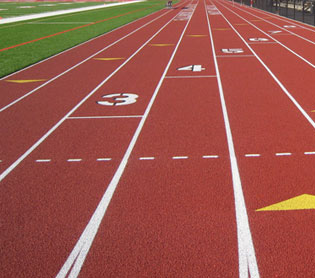
Colored asphalt is quickly becoming a preferred method of rejuvenating areas that otherwise might appear old, boring, dark and gray.
Asphalt paving is mainly seen on interstate highways and suburban streets. Now, with color being added to asphalt it is becoming a widely used process for parks, walking districts and bike paths.
Adding texture and stamped patterns also adds to the appeal. Colored asphalt can also be a great way to incorporate safety into the mix. Asphalt has effective applications for private residential use and commercial developments. These applications add great value and are much more cost effective than stamped concrete, brick or stone pavers.
Color can be added to asphalt in a few different ways. One way is using naturally colored aggregates that begin to show hues of their natural color as the asphalt binder wears away from normal traffic. Additives can also be introduced in the asphalt binder. Iron, slag and recycled glass can give the asphalt mix red, yellow, green, brown or orange tints.
Another method of adding color to asphalt is to coat the surface with a material like Street Print or Asphacolor. These products can penetrate the gaps and adhere to the asphalt pavement. There are many more colors available with this method.
Projects with colored asphalt applications:
Streetscapes in Scottsdale, Arizona—130,000 square feet was installed in 2003 to create level medians, banded traffic circles and other streetscapes.
Waterfront revitalization in Toledo, Ohio ? A forgotten piece of land in downtown Toledo was revitalized with colored asphalt with unique and beautiful pedestrian footpaths.
Campus at UNC (North Carolina)—Colored asphalt was used to enhance the appearance and image of the campus and at the same time capitalizing on the low cost of the application of the decorative pavement.
New Jersey walkways—As part of an urban renewal project that was once a dumping ground, there was an installation of 24,000 square feet of walkways.
Safety is at the front lines of transportation and with colored asphalt safety is easily attained. The ability to differentiate bus lanes, pedestrian cross walks and bike paths integrated into the asphalt pavement has never before been so easily applied. The colored asphalt gives everyone an easy safe environment to move.
Asphalt paving is economical, safe, durable and recyclable. As far as maintenance, asphalt is the quickest and easiest to repair. Colored asphalt is a new and innovative way to incorporate regular asphalt paving into a more viable, marketable material to enhance otherwise basic paving.
Frank Wilson is the Marketing and Transportation Manager at Interstate Asphalt Corporation in Ft. Lauderdale, Florida.














